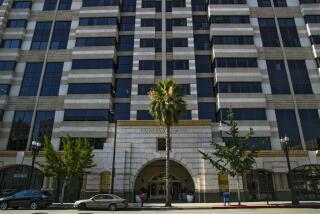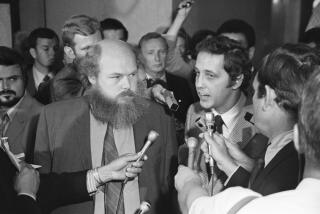Signature Career
- Share via
SOMIS, Calif. — It is a strange and exacting craft, exposing forgery.
For John J. Harris, it has been 49 years of staring at near-identical scrawls to determine whether someone tripped over his own greed.
His craft has taken Harris from a dusty Hong Kong document warehouse to the glaring arena of live TV. He has examined the Byzantine fiscal records of J. Paul Getty, exposed the reputed will of billionaire Howard Hughes as a fraud and dived into the post-mortem squabbling of six women who bore the children of rapper Easy-E.
Harris has hunkered over questionable cursive with a microscope and parsed mystery typewriter fonts down to year, make and model in his search for truth of authorship.
And after nearly half a century in the forensic business--as inkjet printers and high-resolution photocopiers threaten to make the fraud-exposure biz even more challenging--Harris is reluctantly retiring.
In his time, Harris has learned that two things drive men and women to forge--and he has a four-foot-long file drawer full of fake wills to prove it.
“Either a person is an outright crook and he’s trying to steal an estate,” said Harris, 74. “Or it’s a family affair--close friends who have never committed a crime in their life . . . who think they’ve been wronged or think that they knew what the testator wanted but that nobody had put down on paper.”
As the founding member of the American Board of Forensic Document Examiners, Harris helped set certification standards that govern about 200 U.S. and Canadian experts in his profession.
“I would put him at the top,” said Janet Masson, a director of the American Academy of Forensic Sciences. “He’s done a lot for the profession, not least of which, in my judgment, is the fact that he’s a modest man who practiced very well.”
Harris learned the craft from his father, who founded a handwriting-analysis firm in Seattle and worked for the Los Angeles County Sheriff’s Department.
*
As a child, he met the experts who testified on Bruno Hauptmann’s ransom note in the kidnapping of Charles Lindbergh’s baby. By junior high, Jack Harris was collecting typewriter font samples from schools and steno agencies for his father’s specimen bank.
He earned a bachelor’s degree in economics from UCLA in 1948, and joined his father’s firm as an apprentice. Harris later followed in his father’s footsteps as a document examiner for the sheriff.
Harris loved the work. He sniffed out bum I’s and poorly crossed T’s on forged checks and fingered bookies by deciphering coded scrawls they used to take down bets.
He especially enjoyed snaring forgers who wrote fake wills in ballpoint pen and carelessly dated them before 1945--the year ballpoints were invented.
“That was fun,” he chuckled.
In 1957, Harris launched the private practice in Los Angeles that eventually would land him inside many high-stakes legal fights.
When Juan V. Corona was tried in the 1971 mass slayings of 25 itinerant farm workers near Yuba City, Harris was called to verify that a list of victims was in Corona’s handwriting. He matched the ink microscopically to one of only 250 multicolored ballpoints of a certain Italian brand.
After Rock Hudson died of AIDS in 1985, Harris concluded that the movie star had written notes to boyfriend Marc Christian. The finding confirmed the pair’s relationship and strengthened the damage suit against Hudson’s estate by Christian, who netted $14.5 million.
Harris also scrutinized the will of gangsta rapper Eric Wright, known to fans as Easy-E, who died in 1995 and left behind a wife and five other women with whom he fathered children.
Several women wanted Wright’s estate to immediately disburse money--despite a will provision forbidding payout until the children reached 21. The women contended that the initials on the rapper’s most recent will were fake.
But Harris verified Wright’s will, matching the rapper’s block initials to ones penned on recent music contracts. A judge then ordered that Easy-E’s wishes should be upheld.
Harris has examined and testified in more than 1,000 cases, most recently in a Ventura County love triangle murder trial, where he confirmed that Oxnard deli clerk Diana Haun rented the car in which she hacked her lover’s wife to death.
Harris said some cases have left him baffled (“I’ve had some that I’ve stared at and stared at and never made up my mind”) and others have sharpened his eye for the subtleties of human greed.
“Funny things happen when people get into estates, and one person’s going to have the condo in Hawaii and the Mercedes-Benz and the other person’s not going to get anything,” said Harris. “The Hughes people spent a quarter of a million dollars trying to find a will.”
Hughes, a billionaire aviation magnate, died in 1976, apparently without a valid will.
Twenty-four days later, a Mormon church official found a riddle on his desk: an envelope addressed to the church president that contained a second, older envelope, which in turn contained a yellowed, handwritten, three-page document purporting to be Hughes’ last will and testament.
The document stated that Nevada gas station owner Melvin Dummar was entitled to a 1/16th share of the $2.5-billion estate because Dummar found Hughes wandering bloody and disoriented by a desert highway, drove him to Las Vegas and gave him a quarter.
*
Concerned that the will might be a fraud, attorneys for Hughes’ relatives called Harris.
“Our firm was very apprehensive about working on something for eight or nine years where there might be no recovery,” said attorney Paul Freese, who represented family members. “There was a lot of commotion in the firm about, ‘Let’s get out of this thing, it’s too risky.’ But I sold them on Jack Harris. He was pivotal in winning the case.”
Harris was familiar with Hughes’s handwriting. He had testified in a wrongful-termination suit involving Hughes and had once verified Hughes’ signature for the Nevada State Gaming Control Board when Hughes applied for a casino license.
Harris drove to Las Vegas and examined the bedraggled “Mormon Will” flanked by armed guards.
“I looked at the three-page document,” Harris recalled in an article for the Journal of Forensic Sciences. “Looked at it again. And again. The song Peggy Lee made famous came to mind: ‘Is That All There Is?’ What a miserable looking document and what a letdown! Someone had certainly tried to copy his handwriting, but it was no billion-dollar effort. And it had been water-soaked to boot.
“We did not need armed guards! What to do? I really wanted to laugh out loud. This was not the real thing; it was more like a contest in which someone had sent in a facsimile ‘box top’ to enter the ‘Howard Hughes Will Contest.’ ”
But Harris pressed on, examining the document by microscope and taking photographs to confirm his suspicion. It was, he declared several hours later, a rank fraud.
Dummar sued for a share of the Hughes billions and Harris was a key trial witness. He showed the jurors 50 exhibits detailing his examination, down to the different ways that Hughes and the will’s author dotted their i’s. The last one, Freese said, was “the icing on the cake.”
Harris had assembled a cut-and-paste comparison of letters from the Mormon Will and Hughes’ own writing that Harris had arranged to spell out, “This is not my will. Howard R. Hughes.”
“One of the jurors started laughing,” Harris recalled. “And pretty soon all the jurors were laughing. And that was it.”
The jury agreed. The will was a fraud.
Harris looks back on his career with satisfaction, and at the future with trepidation.
“It’s a new generation. We’re approaching a cashless, checkless and signatureless society,” he said. “The future of the work, who knows what it’s going to be like 25 years from now, with all the electronic computer advancements?”
*
Times researcher William Holmes contributed to this story.
More to Read
Inside the business of entertainment
The Wide Shot brings you news, analysis and insights on everything from streaming wars to production — and what it all means for the future.
You may occasionally receive promotional content from the Los Angeles Times.










